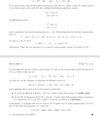Optimising functions of 2 variables Flashcards
(21 cards)
In notes 8 when we looked at optimising functions of one variable what did we do ?
we used differentation to optimise a function of one variable.
What did the first derative and second derative tell us when using differentation to optimise a function of one variable?
1st differential identified the stationary points
the second differential told us whether we had a max or min,
When did we have a local maximum and when did we have a local minimum, when using second derative test to optimise a function of one variable?
local maximum at x= a if f’(a) = 0 and f’‘(a)<0
local minimum at x = a if f’(a) = 0 and f’‘(a)>0.
In notes 11 our did we optimise functions of 2 variables and what was wrong with it?
The problem is that this only works for specific functions

We are going to use a different method to now optimise functions of 2 variables, first of all what are we going to find and how do we find it?
We find partial deratives with respect to x and with respect to y and equate them meach to 0 and factorise or solve simultaneously to find the cricital points.





When solving for critcial points and its not clear to complete the square or to factorise as in your partial deratives you have a mixture of x and y, how do we find the critical points?
We solve them simultaneously

Whats important to remember is that when they equal 0, the first order partial deratives, they change sign when you have a mixture of x’s and y’s.



So after finding the critical points of a function of 2 variables what can we do?
We can determine their nature of the cricital points.
How can we determine the nature of our crtical points of a function of 2 variables?
We have to find the hessian of the function

So now with the hessian of the function what are the rules in determing whether we have a maximum or a minimum or a saddle point?


Find the crictial points and determine its nature?








How do we denote a firm maxmising revenue for selling 2 goods?

What is the profit function of a firm, selling 2 goods x and y?


TBA


